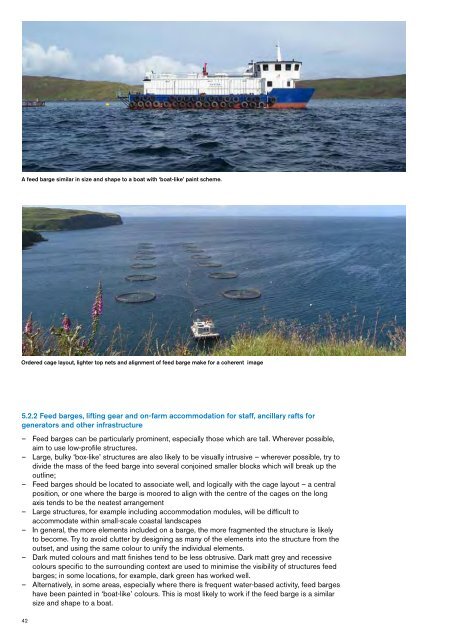The siting and design of aquaculture in the landscape: visual and ...
The siting and design of aquaculture in the landscape: visual and ...
The siting and design of aquaculture in the landscape: visual and ...
Create successful ePaper yourself
Turn your PDF publications into a flip-book with our unique Google optimized e-Paper software.
A feed barge similar <strong>in</strong> size <strong>and</strong> shape to a boat with ‘boat-like’ pa<strong>in</strong>t scheme.<br />
Ordered cage layout, lighter top nets <strong>and</strong> alignment <strong>of</strong> feed barge make for a coherent image<br />
5.2.2 Feed barges, lift<strong>in</strong>g gear <strong>and</strong> on-farm accommodation for staff, ancillary rafts for<br />
generators <strong>and</strong> o<strong>the</strong>r <strong>in</strong>frastructure<br />
––<br />
Feed barges can be particularly prom<strong>in</strong>ent, especially those which are tall. Wherever possible,<br />
aim to use low-pr<strong>of</strong>ile structures.<br />
––<br />
Large, bulky ‘box-like’ structures are also likely to be <strong>visual</strong>ly <strong>in</strong>trusive – wherever possible, try to<br />
divide <strong>the</strong> mass <strong>of</strong> <strong>the</strong> feed barge <strong>in</strong>to several conjo<strong>in</strong>ed smaller blocks which will break up <strong>the</strong><br />
outl<strong>in</strong>e;<br />
––<br />
Feed barges should be located to associate well, <strong>and</strong> logically with <strong>the</strong> cage layout – a central<br />
position, or one where <strong>the</strong> barge is moored to align with <strong>the</strong> centre <strong>of</strong> <strong>the</strong> cages on <strong>the</strong> long<br />
axis tends to be <strong>the</strong> neatest arrangement<br />
––<br />
Large structures, for example <strong>in</strong>clud<strong>in</strong>g accommodation modules, will be difficult to<br />
accommodate with<strong>in</strong> small-scale coastal l<strong>and</strong>scapes<br />
––<br />
In general, <strong>the</strong> more elements <strong>in</strong>cluded on a barge, <strong>the</strong> more fragmented <strong>the</strong> structure is likely<br />
to become. Try to avoid clutter by <strong>design</strong><strong>in</strong>g as many <strong>of</strong> <strong>the</strong> elements <strong>in</strong>to <strong>the</strong> structure from <strong>the</strong><br />
outset, <strong>and</strong> us<strong>in</strong>g <strong>the</strong> same colour to unify <strong>the</strong> <strong>in</strong>dividual elements.<br />
––<br />
Dark muted colours <strong>and</strong> matt f<strong>in</strong>ishes tend to be less obtrusive. Dark matt grey <strong>and</strong> recessive<br />
colours specific to <strong>the</strong> surround<strong>in</strong>g context are used to m<strong>in</strong>imise <strong>the</strong> visibility <strong>of</strong> structures feed<br />
barges; <strong>in</strong> some locations, for example, dark green has worked well.<br />
––<br />
Alternatively, <strong>in</strong> some areas, especially where <strong>the</strong>re is frequent water-based activity, feed barges<br />
have been pa<strong>in</strong>ted <strong>in</strong> ‘boat-like’ colours. This is most likely to work if <strong>the</strong> feed barge is a similar<br />
size <strong>and</strong> shape to a boat.<br />
42

















